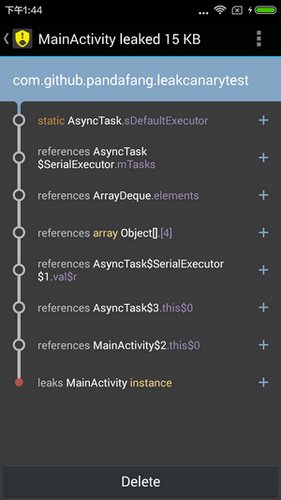Android内存泄漏排查利器LeakCanary
开源地址:https://github.com/square/leakcanary
在 build.gralde 里加上依赖, 然后sync 一下, 添加内容如下
dependencies { .... debugCompile 'com.squareup.leakcanary:leakcanary-android:1.5' releaseCompile 'com.squareup.leakcanary:leakcanary-android-no-op:1.5' testCompile 'com.squareup.leakcanary:leakcanary-android-no-op:1.5' }
省略号代表其他已有内容
在 Application类里面将 LeakCanary 初始化。。 比如叫MyApplication ,如果没有就创建一个,继承 android.app.Application。 别忘了在AndroidManifest.xml中加上,否则不起作用
public class MyApplication extends Application { @Override public void onCreate() { super.onCreate(); if (LeakCanary.isInAnalyzerProcess(this)) { // This process is dedicated to LeakCanary for heap analysis. // You should not init your app in this process. return; } LeakCanary.install(this); // 你的其他代码从下面开始 } }
官方已经有demo了,可以跑跑看。
package com.github.pandafang.leakcanarytest; import android.app.Activity; import android.os.AsyncTask; import android.os.Bundle; import android.os.SystemClock; import android.view.View; public class MainActivity extends Activity { @Override protected void onCreate(Bundle savedInstanceState) { super.onCreate(savedInstanceState); setContentView(R.layout.activity_main); View button = findViewById(R.id.async_task); button.setOnClickListener(new View.OnClickListener() { @Override public void onClick(View v) { startAsyncTask(); } }); } void startAsyncTask() { // This async task is an anonymous class and therefore has a hidden reference to the outer // class MainActivity. If the activity gets destroyed before the task finishes (e.g. rotation), // the activity instance will leak. new AsyncTask<Void, Void, Void>() { @Override protected Void doInBackground(Void... params) { // Do some slow work in background SystemClock.sleep(20000); return null; } }.execute(); } }
进入主界面按下按钮, 再按返回键退出主界面, 反复几次,LeakCanary 就能探测到内存泄漏了。注意要多操作几次,1次的话泄漏规模太小,可能不会探测到。LeakCanary 一旦探测到会弹出提示的。
回到桌面,会看到一个LeakCanary 的图标,如果有多个app 用到就会有多个LeakCanary图标。

点进去就会看到内存泄漏记录

再点进去就可以看到调用栈了




